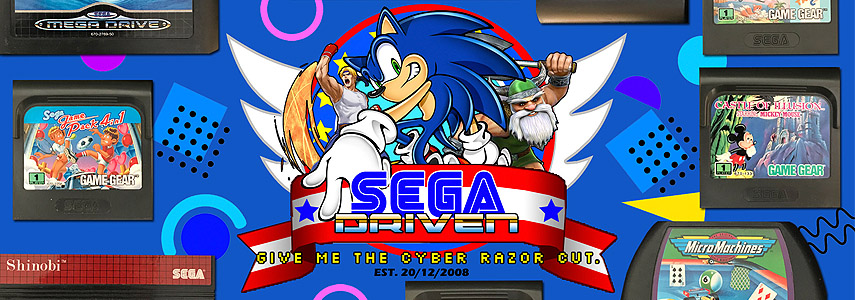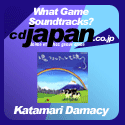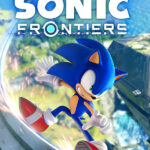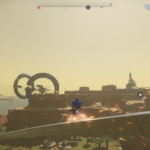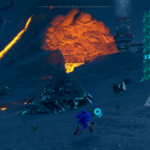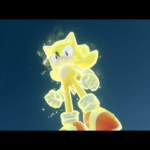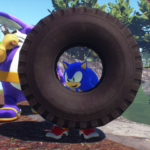Sonic Frontiers – PC Review
PC Version Written Review
This review contains details that may be considered mild spoilers for Sonic Frontiers, though presented without story context to mitigate this.
The release of a new Sonic game has become a somewhat sad affair over the course of the last decade, right after it seemed like he was finding his footing with games like Sonic Colours and Sonic Generations. Since then we got the atrocious Sonic Lost World, the overwhelmingly mediocre Sonic Forces, and a racing game with broken online multiplayer that was never fixed. Just to rub salt in the wound, we got a port of Colours that completely missed the mark. Yes, we got the sublime Sonic Mania in 2017, but that was the exception rather than the rule. And do we even need to bring up Sonic Boom?
I was justifiably sceptical of Sonic Frontiers. It was good to see Sonic Team move away from the linear ‘boost’ formula, after Forces showed it had probably run its course – but Lost World was also supposed to be a gameplay paradigm shift, and it ended up being worse than almost anything before it. I studied the questionable reveal footage from IGN, the bits of combat we saw, and the blatantly rehashed cyberspace levels, and thought that despite everything, we were set for another deflating release from the house of hedgehog.
So after nearly two full run-throughs of the game, it brings me great joy to say that Sonic Frontiers is the best Modern Sonic title released in the past 10 years. In fact, there’s elements of it I think I enjoy more than Generations! It’s also, however, a game with no shortage of issues; in ways that often feel much like ‘first game syndrome’ for the ‘open-zone’ concept that Takashi Iizuka believes could form the future of Sonic games.
Frontiers opens with Sonic and his friends heading to the Starfall Islands, after detecting the Chaos Emeralds have shown up there. A wormhole ambushes them, and Sonic wakes up alone and with only a disembodied voice guiding him. As you play through the game, the mystery behind the islands and their history unravels, into an intriguing tale that genuinely adds to the lore and mythos of the Sonic the Hedgehog canon. We’re also introduced to a new character, Sage, whose arc over the course of the game is a far cry from the one-note nonsense seen with Infinite in Forces, or the Deadly Six in Lost World. She pans out into a genuinely interesting character, and one I’d love to see more of in some way. Ken Pontac and Warren Graff have been shown the door, as longtime Sonic comic scribe Ian Flynn is in the writer’s chair this time around – and it certainly shows. The English script is mostly solid, and once again stands as a huge departure from recent memory. The characters feel more maturely written, and aren’t cracking awful jokes every 20 seconds – and when they do crack jokes, they actually land. Flynn does fall into a few of the trappings evident from his comic run though, namely the amount of references sprinkled in. While it’s nice to see characters refer to past events and characters when they’re relevant to the plot at hand, sometimes it feels like Flynn’s trying a little too hard to prove he’s a bigger Sonic nerd than you. Tails probably makes the lion’s share of these nods, and while some are used to decent effect (to build up a new character arc, or even to foreshadow a later boss), some just feel silly. On the other hand, some of these references serve to suggest the direction Sonic’s worldbuilding may go under Flynn, and it’s a direction that’s far more confident in its past and continuity than previous games were – probably because Flynn did more than give Sonic’s Wiki page a once over.
Visually, Frontiers looks alright. Much has been said about the ‘realistic’ look the Starfall Islands opt for, but I personally don’t find it any more ill-fitting than any of the locales seen in the Adventure series. There’s strange floating monoliths in Kronos, a massive rollercoaster-like track situated between two giant spirals in the skies of Chaos, what looks like an abandoned industrial area of Ares… I do wish areas like these were integrated into the map more often, as they tend to be the stand-out setpieces of each zone, but their presence does help the environment feel more Sonic-y. Sonic himself also looks a lot healthier than he did in Forces, with nice new textures that give him decent looking fur, something even the CG promo models have struggled with.
Cutscenes are strangely locked to 30fps and I’m not too sure why, as at one point I happened upon a glitch that caused them to run in 60fps and it all seemed totally fine. The resolution of them also takes a nosedive for some reason, making in-engine cutscenes look like PS2 FMVs. If you play the game in 4K it apparently gives you higher quality cutscenes, but on a 1440p display I’d rather use those than the much lower resolution ones. Animation-wise, it’s an extremely mixed bag, with some scenes boasting the best animation Sonic Team’s ever put out in-engine, and others looking like an amateur Source Filmmaker project. The opening scene featuring Eggman is so poorly done I actually burst out laughing, and in general the animators seem to struggle with him the most. It’s weird, because even in Forces he was decently well animated.
I think the biggest issue with the game on a technical level is the pop-in. The Hedgehog Engine 2 was not built with a huge open space in mind, and the result is that objects will simply appear in front of you at an embarrassingly close range. I’m not sure how they can actually go about fixing this besides reprogramming how the HE2 handles it, but I hope they can figure it out for next time. The PC version doesn’t even have render distance settings, which was a major let-down. Thankfully the PC version seems to run fine on the whole though, particularly compared to the unusually stutter-heavy Sonic Colours Ultimate – although the lack of an unlocked framerate option is unfortunate, given both Forces and Colours Ultimate had that feature, and it looked phenomenal there.
Frontiers is a huge paradigm shift for the actual gameplay of the series. Instead of a series of levels, Sonic is now plunged into a series of ‘Open Zones’. At first I wasn’t convinced by the marketing that these were anything other than differently named open world environments, but after playing I can somewhat understand the reason for the distinction. In a game like Breath of the Wild, you’re plunged into a single, huge world where you can beeline right for the final area if you want to. Frontiers, meanwhile, is still essentially split into ‘levels’ – just really big levels, with small setpieces splashed across the world. Most of the islands do feel like a big playground, with rails and loops suspended around them – though this also a fault, as the set pieces don’t really feel like part of the world. It’s more like if someone dropped random Sonic ‘stuff’ into Zelda’s map, with even loops being obviously constructed of just multiple platforms stitched together. It’s somewhat sloppy, and it’d be more satisfying to see these grandiose grind rails be incredible structures, extending from the world itself. Instead they’re all sort of just… there. These setpieces are at least decently fun to mess with though, often rewarding the player with one of several collectibles for completing a short obstacle course. To that end, it actually reminds me a lot of the phenomenal Bowser’s Fury, a smaller game included with Mario 3D World’s Switch remaster.
That said, the variety isn’t quite a wide as something like Bowser’s Fury, and even when the difficulty starts getting turned up later on, the platforming challenges can feel somewhat homogenised. Each island typically has one unique platforming challenge that feels a little more thought out than the rest, as I pointed out back when talking about the visuals, and they’re arguably some of the few moments where it feels like I’m racing through a lovingly constructed platform challenge, with assets that suit the world and sometimes make fantastic use of Sonic’s returning (and thankfully much improved) parkour system. I’d love to see every platforming challenge feel like this in an open zone sequel.
I’d argue a lot of the fun in Frontiers comes from finding ways to do these challenges in your own way, though. Yes, you could enter the obvious ‘start’ of a challenge area, platform through it, and find your way to the end… or you could scale up that hill, run down, launch yourself off a rock or small ramp, and get to the objective that way. This is especially the case for rails, where jumping off them carries a frankly insane amount of momentum that makes blitzing through the world extremely fun. Playing with with Sonic’s physics ends up being quite fun, such as boosting off the edge of an upward incline to launch Sonic across the horizon, doing a satisfying string of tricks across the sky. I love pulling off daft looking skips and physics exploits in games like Adventure 2, and now the whole world is your oyster to experiment in. Frontiers’ options menu even offers a variety of sliders to alter even the most niche facets of Sonic’s control; some could argue this is Sonic Team giving up on making a solid, widely accepted control scheme, but I appreciate being able to tune Sonic in this way. To this end, one of my only major complaints with Frontiers’ controls is how little momentum Sonic has when not leaping off the rails, as jumping often slows you to a crawl, but to inconsistent degrees. It feels awkward and can make messing around in the open-zone feel more cumbersome than it should’ve. Sonic also has an annoying tendency to stick to the ground, even when it feels like he should’ve flown off something like a ramp. It’s far from the worst feeling Sonic game in the world, and I’d argue the physics feel similar in some ways to the Adventure titles in this regard – which I prefer to how uncontrollably fast Sonic can feel in many ‘momentum-based’ fangames – but it’s something I’d like to see tweaked for next time. That also goes for the Drop Dash, which Sonic actually has in 3D for the first time. It’s very fun to use, but again feels like it runs on a very inconsistent and weird set of physics that it’d be great to see properly polished up. On the whole though, it’s still a far cry from how stilted Sonic felt in games such as Forces, and makes for a good time overall. Sonic’s also rocking a new ability named the Cyloop, which comes in handy for a great many things – often if you’re stumped as to how to interact with something, the answer is to Cyloop it. I worried this ability would break Sonic’s pace, but you can boost while performing it and use it as a pretty versatile tool in a lot of situations.
Frontiers’ basic gameplay loop consists of a string of collectables. You collect Portal Gears from defeating Guardians, essentially minibosses strung across the map. The Guardians end up offering quite a bit of variety in how you fight them, with some using traditional Sonic level design elements like Grind Rails as part of the fight, or testing reflexive use of Sonic’s basic moveset. In a way, it reminded me of the Mega Drive’s Alien Soldier, with an almost boss rush style vibe. They’re also where the biggest shift in Sonic’s gameplay comes in, boasting a new combat system. Sonic can throw punches and kicks again for the first time since 2008, and mercifully it feels a lot more at home with how it’s done here than it was then. There’s an almost obligatory skill tree to uncover, and while I’d stretch to call the combat ‘deep’ it offers a lot of options for tackling enemies. This includes the Cyloop, which can be used to break down enemy shields or launch them into the air – and there’s even an unlockable ‘Quick Cyloop’ that can be used in midair, to smash enemies back down into the dirt or achieve other neat effects. Admittedly I groaned a bit when enemies started shielding on the second island, as the only means of stopping it was the Cyloop – which didn’t feel very gracefully integrated in this instance. But you can also target them via other means, such as sliding into them at full throttle! Finding these different means of fighting enemies was quite interesting, as was watching Sonic’s collection of attacks expand over the course of the game. In the end, it all winds up feeling entertainingly flashy, and offers some room for experimentation.
If I have any major complaint with the combat, it’s that the button mapping often feels like an afterthought. For example, the Loop Kick move is supposed to activate using a button combo involving the Right Trigger and B Button, while in midair. But I found it would activate if I so much as touched the B Button by itself near enemies, even when grounded – so my fun strategy of sliding into enemies to circumvent their shields was now moot, because trying to slide would just make Sonic launch into a flashy animation I didn’t actually want him to. Sadly this happens with several moves, including one that’s bafflingly linked to a combination involving the Boost Button and the basic attack one – so if you try to boost into an enemy and tap the attack button for a homing attack, Sonic will instead freeze in midair, play a short cutscene of launching orbs at the enemy (which is pretty strange in of itself) and then fall like a rock since his intended homing attack target’s most likely dead from the orbs. The window for the button combos is simply too lenient – imagine if pressing the jump button about 2 seconds after leaving a crouch in Mario 64 still led to a Long Jump, and you’ll get a feeling of how overly generous that window feels here. I’d rather the skill system just let you pick the skills you wanted, rather than being a ‘tree’, so I could skip the skills I don’t want and just grab the ones I do; or at the very least allow me to disable the skills I didn’t want to activate, as you can with the unlockable Auto-Combo skill.
The Portal Gears that Guardians drop allow you to activate portals to Cyber Space stages, that are basically short, traditional Sonic levels. These aren’t really intended as full-length ‘acts’, and have an arcade-like feel to them – in fact, the concept is taken straight from Phantasy Star Online 2: New Genesis’ Cocoons. Like those, these levels have a set of four ‘missions’ to complete, which typically involve beating the stage, beating it in a set time, beating it with enough rings, and collecting the hidden Red Star Rings within them. This makes them quite replayable, and each of the missions that you clear will earn you a Vault Key, a certain number of which will let Sonic claim a Chaos Emerald from the Open-Zone area. In theory these are a fun little diversion from the main gameplay, and the bite-sized nature makes them a sensible way of getting the keys needed to progress. There’s just a small, tiny catch – they have possibly the worst controls of any of the ‘boost’ Sonic games.
It’s baffling considering Sonic feels totally fine in the open-zone but in Cyber Space, Sonic is sluggish, heavy, difficult to turn – it feels like the controller is covered in tar. It makes these stages far more frustrating to play than they needed to be, and to touch on another problem with these stages, far more frustrating than they were the first time I played them over 10 years ago. Almost every Cyber Space level in the game is ripped straight from a previous Sonic game, with Sonic Generations, Sonic Unleashed and for some reason, Sonic Adventure 2 being the games plundered for level design. After positioning Frontiers as such a huge paradigm shift, it feels silly to start outright using past stages, level design and all – but even worse, when a stage like Green Forest shows up it’s just reskinned to look like Green Hill Zone! There’s only four ‘themes’ for Cyber Space – Green Hill, Chemical Plant and Sky Sanctuary return from Generations, in addition to an at least somewhat unique looking city theme. Green Hill is one thing, but I’m beyond tired of seeing Chemical Plant and Sky Sanctuary come back too, let alone being used to reskin other stages. The Red Ring placements also feel somewhat pointless, and rather than rewarding exploration of any alternative routes retained from adapting the old level designs, they tend to be placed along the most basic main path – when just beating the level is already a mission. They went to the trouble of recreating Sky Rail’s entire Lost Chao route, but there’s nothing actually there to make it worth taking! On the whole Cyber Space feels like a waste of time, time that could’ve been put into improving the Open-Zone. The stages can be somewhat fun to time attack, but it’s always whilst being frustrated by the controls – even with the somewhat glitchy tech players have already discovered to make them a little more exciting to blast through, in a way that harkens back to the likes of Adventure 2’s ‘superbounce’ tech, I’d rather just time attack them in the games where they actually controlled well.
The final set of trinkets to grab are Memory Tokens, that take the form of a Heart, a Medal, or a Wrench, depending on the island. These are usually at the end of platforming challenges, and are used to ‘stabilise’ Sonic’s friends – who’ve found themselves stuck in a ghostly state, trapped in Cyberspace. Once you’ve got enough of their tokens, you’ll be able to speak to them and advance the story through a series of cutscenes. Again, the writing here largely shines, and it’s some of the best character interaction in any Sonic game; Sonic feels a lot more mature here than the previous Modern titles, and the genuine care he shows for his friends as they all essentially start new character arcs is extremely heartwarming. Tails in particular hits a mental rough patch, and the way Sonic tries to help pick him up was wonderful to watch. What’s not so wonderful is the voice acting, sadly. The voice direction has been massively overhauled, and it feels inconsistent at best. Amy probably gets it the worst, but Sonic’s new voice direction gives him a deeper tone that takes more than a little getting used to, and results in some odd delivery at many points. Knuckles’ latest voice actor turns in a considerably better performance than in Team Sonic Racing, but at points it still feels like he’s finding his footing in the role. Even some of Mike Pollock’s line reads feel questionable, although the unlockable Egg Voice Memos that shed extra light on the story from Eggman’s perspective (while laying the fanservice on thick) portray a range of emotions that are conveyed quite well on the whole.
Speaking of which, there’s one other way to get all of these trinkets and more – fishing! At first that might seem like a terrifying prospect considering how well it went 20 years ago in Sonic Adventure, but fishing in Sonic Frontiers is a far more simple, and actually quite relaxing affair. Big the Cat does of course make an appearance, with Sonic finally questioning his habit of just showing up wherever he pleases. You can purchase the various collectables on offer from Big using the tokens obtained via fishing, and these can actually be very helpful for alleviating the potential grind. I didn’t really find any moments where I was egregiously low on tokens or vault keys anyway, nothing to the extent of Sonic Unleashed’s infamous Sun and Moon medals – but the fact there’s a fairly quick and efficient way to mop up some extras is very, very much appreciated. In fact, getting fish tokens to spend has been made even easier at the time of writing, by the introduction of some new Monster Hunter DLC that includes the classic cooking minigame from that series. Fishing requires purple coins found across the world – but every now and then, a meteor shower will happen in the open-zone and give you the opportunity to get more fish coins than you’ll ever need with a roulette minigame. To be honest, the roulette minigame is somewhat poorly implemented; it’s overlaid on top of the gameplay, even during fights with Guardians, and can very easily obscure your view in critical moments. There’s no way to disable it either, which is especially irritating when you’ve already maxed out the Purple Coin counter. That said, the idea of a random event that suddenly turns the entire world into a mad scramble for fallen stars is a fun idea, and I did get a kick out of seeing how many of them I could mop up before daylight broke.
Eventually, you’ll find yourself with all the Chaos Emeralds. Some are actually reserved for missions you’ll get by advancing the story, hence the importance of Memory Tokens – these missions are nothing to write home about, but do offer a little bit of variety to the usual open-zone/cyberspace shenanigans. Each island then has a puzzle of some description, to open the way to the giant Titans stalking the world. Weirdly, the first island boasts the most difficult of the three, before the second island has you… do basic colour matching. The third island’s minigame is a fun idea, let down by poorly programmed physics and a terrifying points requirement; it does bring a very unexpected musical contribution that had me grinning ear to ear, at least. Once the minigames in question are done and dusted, Sonic has to claim the final Emerald of the island by climbing onto the giant Titan itself. And once that’s done, Sonic goes Super… for some of the most utterly insane, and downright magical boss fights in Sonic history.
It’s undeniable that the Titan fights in this game are style over substance. They’re fairly janky too, with some camera and collision oddities occasionally getting in the way at times.
They’re also absolutely mental, with the most 2009 heavy rock music the series may have ever seen blasting in the background, as Sonic lays into the gigantic mechs with his vast array of combat moves – now pumped up to levels befitting Super Sonic. The scale of these fights is genuinely awe-inspiring, and every single one had me pumped up more than the last. The third island’s in particular is staggering, with the end of the battle leaving my jaw dropped at what I’d just seen. I was worried they’d wear out Super Sonic’s welcome with these bosses pretty fast, and that each boss would feel samey, but the fights are utterly fantastic and like an injection of pure serotonin to the brain. There’s actually some depth to the fights too – not tons admittedly, but the second time I fought the second boss I encountered an incredible QTE sequence I’d never seen the first time around, and experimenting with Sonic’s Quick Cyloop ability on them turned up some extremely satisfying results. Ironically, the biggest let-down in this regard is the last Titan, who feels fairly basic compared to the madness of the third island’s fight. It’s also a shame there’s no way to replay these fights at all right now, besides loading up a save from before the fight – which can be hard to do, as Frontiers gives you a meagre 3 slots, plus an autosave slot.
There is one aspect of Frontiers that feels a bit cheeky, given the official site boasts of racing across “the five massive Starfall Islands.” Without going into spoilers too much, this is… a flat-out lie. In reality, there’s only 3 separate islands, with the last two being parts of Kronos, the first island, blatantly carved out into something separate. It’s especially noticeable on the second to last island, which isn’t particularly massive and has no actual exploration value – it’s got a story-based objective to complete, and once that’s done and the story’s advanced, there’s literally no point in returning to it unlike the other islands. You can even see the rest of Kronos from a vantage point on this ‘island’, so it just feels like Sonic Team playing people for fools. It’s irritating too, as it’s a particularly beautiful part of Kronos that would’ve been just as much fun to race around had they populated it with reasons to do so beyond the story objectives. The final island fares better, and comes in at a similar scale to the other islands with more to explore and find – but it’s still very obvious that it was just cut-out from Kronos to make a smaller, separate island (even reusing the Heart-shaped Memory Tokens, when they arguably don’t make any sense at this point), and it’s confusing that they didn’t just have you return to a newly expanded Kronos later in the game to convey these story beats rather than trying to pass off segmented content as ‘new islands’ for the sake of a bigger number.
As mentioned, the last Titan is somewhat underwhelming – but one piece of advice I’d give to anyone playing Frontiers is to play on Hard Mode, as it unlocks a little something extra towards the end. Already I’ve seen Sonic fans tear this extra tidbit a new arsehole, as possibly the worst finale in Sonic history – but to me, it was something so unexpected, so surprising, and so weirdly tailored to my interests specifically that it absolutely made my day, and built up to a moving ending that left not a dry eye in the house. With the final Titan in mind though, as well as the way the last two islands play out, it does feel like Sonic Team started to run into deadlines towards the end of development. Which is unfortunate to see, given how ambitious and constantly escalating the rest of the game feels.
It’s an adage as old as time – that even the worst Sonic games still bring good soundtracks with them, if nothing else. Thankfully, Frontiers is yet another smash hit in this regard, and arguably a return to form for Tomoya Ohtani after the questionable instrumentation of Forces. I didn’t expect to enjoy the themes for the Starfall Islands as much as I did, as they’re quite sombre, more laid-back pieces than the high-energy rock anthems typical of Sonic stages. But it works quite well, and makes for good listening as you rocket around the environment. For those missing a more high-energy sound though, the Cyber Space levels bring this in spades. Ohtani very smartly recruited several musicians from SEGA’s rhythm game sound team, who’s collective repertoire includes titles such as MaiMai and Chunithm, to bring a new sound to Sonic’s traditional action stages. It pays off massively, with a huge range of dance music genres represented. From jungle, to house, to even some sort of pseudo-eurobeat, there’s scarcely a bad track amongst the Cyber Space levels, and actually plays a huge role in alleviating the underwhelming nature of these stages to some extent. As mentioned already, the Titan fights boast extremely over the top nu-metal, that makes every one of them into an event, and utterly exhilarating to play. Even the credits boast 3 unique songs (including the licensed track ‘Vandalize’ by Japanese rockers ONE OK ROCK), and they’re all sublime.
Ultimately, it’s obvious that Sonic Frontiers has plenty of issues, and towards the end of the game it feels like Sonic Team simply had to cut corners. It’s frustrating, but the good news is that despite these qualms, this game nails being simply fun to play. In a sense, a lot of these issues feel like the ‘first game syndrome’ I mentioned at the start, as the formula is brand-new and hasn’t been refined yet. If the team can study these problems, and properly iterate on them – integrating momentum-based movement into the game design being should be their main priority now, especially as values to do so are seemingly in the game’s files – then the follow-up to this game should be something genuinely special. As it stands though, Frontiers is still a game I have no problems recommending. For all its problems, they don’t overtake the entertainment I get out of simply sitting down and playing it, unlike many other Sonic games. Even the naff Cyber Space stages still aren’t as jarring as something like the Werehog. On launch day I sat down and played it for 16 hours straight – it’s been a long while since a 3D Sonic game has had its hooks in me in quite that way. In Breath of the Wild I get a great amount of joy from just running around the world and setting my own adventures, and Frontiers already starts to capture that same magic by virtue of Sonic’s movement options – especially with fun exploits like grind rail jumping thrown into the mix, or Sonic’s ability to do silly tricks off just about everything. Even with the lack of more traditional physics, I do find Sonic’s basic movement in this game to be the best he’s felt since the Adventure days, with a return to more precise platforming controls and a better sense of weight to his running. It all just needs a lot of polish, and maybe better planning to make sure the true scope of the game can be realised without cutting corners.
But if this is truly setting the stage for the future of Sonic? Then I’m on board. I’m truly hopeful for what lies ahead for the games, provided Sonic Team learn the right lessons from this first attempt at the ‘Open Zone’. For the first time in nearly a decade, I think Sonic’s future might actually be a bright one.
7.5/10
Written by Liam “Tracker” Ashcroft 20/11/2022
PC Version Video Review
Produced by Lewis “Sonic Yoda” Clark & Pete “Titans Creed” Nethercote 13/11/2022
Cover Art
Screenshots
